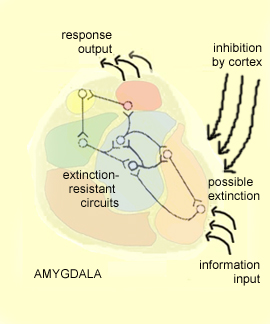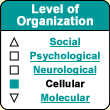|
|

 |
 |
Some researchers believe that the amygdala
may contain certain circuits that are pre-wired but not normally
connected to the circuits that trigger emotional responses.
Thus a traumatic event (for example, a
baby monkey seeing its mother be afraid of a snake ) might not create a fear circuit from scratch, but might
simply connect one that was already there.
We can thus imagine how some people's brains, because of early influences or genetic predispositions (such as especially sensitive pre-wired circuits) might react to certain traumatic experiences by developing phobias.
It would also seem that fear extinction depends on the same
synaptic learning mechanism as fear conditioning in the amygdala
or explicit long-term memory in the hippocampus: the activation
of NMDA
receptors. Thus, if the NMDA receptors are
blocked, the process of extinction is disturbed, and the amygdala
does not learn how to inhibit an especially anxiety-producing
memory.
|
|
|
| THE TRACES OF ANXIETY IN THE CIRCUITS OF THE AMYGDALA |
|
It was long believed that a particular sensation, emotion, or thought
represented activity in one particular part of the brain, relatively
isolated from any others. But increasingly, this belief is yielding
to a more sophisticated view: that neural representations result
from the activity of multiple circuits, distributed across various
parts of the brain and interacting dynamically.
In the case of anxiety disorders, the locus of the conditioned fears that cause
the various excessive manifestations of anxiety seems to be the
numerous neural connections among the various nuclei of the amygdala.
But the part of the brain
that can potentially relieve these fears embedded deep in the
amygdala is the vast surface of the cortex, where rational
thinking takes place. Because of its great plasticity,
the cortex can inhibit sub-cortical structures sufficiently
to contain fears that have become inappropriate. This is the
process of extinction
that is applied in behavioural therapy.
Many experiments, by researchers such as Quirk, Repa, and LeDoux,
support this model. These scientists recorded electrophysiological
activity in the neurons of the amygdalae of rats that were
subjected to a sound that produced a conditioned fear. The
recordings showed a dramatic increase in the electrical response
of these neurons when the sound was generated. And this increased
activity was indeed reversed after the conditioning was extinguished. |
|
 |
By making recordings in different cells simultaneously, these
researchers were also able to observe the relationships that these
cells maintained with one another. These recordings showed that
conditioning increased the coupling between certain neurons, so
that the probability of two neurons' firing at the same time was
greatly increased. But the most interesting finding was that for
some cells, this coupling was not diminished when the conditioning
was extinguished.
Conditioning thus seems to create special “assemblies of neurons” in
the amygdala, many of which are resistant to extinction. Though this hypothesis
is still speculative, this experiment also supports other observations indicating
that the traces of conditioned fears in the amygdala are permanent and that inhibition
by the cortex is the mechanism responsible for extinguishing them.
|
|





